Social networking
Iman Moradi, October 2007
Before the rise of the worldwide web, the Internet was already a successful model for allowing communities to form and share information. Newsgroups, mailing lists and countless forums and multi-user environments existed which allowed us to express our views and practice being social. It has been fittingly said that the Internet augmented traditional forms of communication and added to people’s social ties. (Irina Shklovski, 2004) [1]
Despite the opportunities and new modes of social communication that these augmentations allowed us, it's safe to say that what was on offer then was never as pervasive, inviting, interactive or facilitating as what we can enjoy today. As the web has developed, so too have the skills of countless specialist internet programmers and our insatiable appetite to communicate, consume and play with information in new and varied ways.
As a result, the web is now teeming with internet applications which are user friendly, rich in functionality and crucially provide features which allow us to form and maintain social ties in a manageable fashion. We can now exchange knowledge, benefit from aggregated views, share our personal media, access, manipulate, describe and generate items of data with unparalleled ease.
What is known in the industry as a perpetual beta,[2] refers primarily to how new, often experimental and cutting edge features are continuously integrated to such online services and software. Many of these features, usually offered freely, easily rival and surpass the potential benefits of locally installed paid for and free desktop software as they are developed quickly with a steady eye on direct user feedback and usage patterns.
However with the great potential that these tools have, there are some serious tradeoffs as well. The very mechanisms which allow us to enjoy social experiences and get things done quicker and more conveniently can potentially be put to other end uses as well which we may or may not find agreeable.
Of these concerns, there are the anticipated issues associated with implicitly entrusting our content with the service provider and third parties which ‘they’ trust, but more disconcertingly our mere interactions with any of these tools inevitably leave a rich information trail as well which can be stored and analysed without our knowledge or direct permission.
The broadly worded user license agreements or terms of service documents for these tools and services basically allow the companies which operate them great liberties to utilise any information we share with them, or any content we create, which may include tracking our usage even at times when we are not using their services! [3]
Whether the end purpose of any of these activities is to deliver a better more customised service, target us with advertising, sell our usage data to third parties, indemnify the providers from any responsibility when something goes wrong, or grant them rights to freely own and use our content as they please, it is all possible and indeed nonetheless questionable. [4]
This article aims to introduce a select few of the most well known tools for collaboration. It does so critically, highlighting their potential to enhance existing methods of communication and the way we work, as well as mentioning some of their drawbacks and pitfalls.
This article is aimed primarily at new users who want a starting point or introduction to an interesting and rapidly growing area of development.
Web 2.0 and Social Software
The Internet is awash with buzzwords and hype. You may read or hear some terminology which never existed until a couple of years ago. Some of this terminology is very specific, Blogs and Wiki’s are examples of such, and they are clearly defined things which have, needless to say, been around for a while. A Blog, short for weblog, or a Wiki both allow you to edit and update content which others can see, they are names for two generic types of product, with several variants and configurations and mutations of each available to use.
Blogs are like online diaries or journals, with each entry having a date and an archive of previous entries. Wiki’s, such as the Wikimedia Foundation’s suite of wikis and their online encyclopaedia “Wikipedia” referenced in this article, are non-linear flexible repositories which allow specific users or anyone to create pages, edit and interlink content while keeping a record of revisions and changes. Both are viewable within a web browser without any additional software being required. Open Source Blogging systems such as Wordpress [5] have also brought ease to blogging and many commercially hosted systems exist to allow users to maintain blogs without any technical know-how [6].
These days however, other terms can be quite nebulous and can cover a number of different things. Web 2.0 (usually expressed two-point-zero, or two-point-o) is such a term. Web 2.0 is not the name of a new technology, but rather a way of referring to group of common technologies and methods which websites and associated services are developing and supporting to facilitate ‘greater collaboration and sharing between users’. [7]
Social Software itself is the blanket term used to categorise tools which allow us to communicate and interact with other users, and although that in itself is nothing new, today this term is widely being used to describe web based software which adheres to some basic Web 2.0 principles.
The Wikipedia article on Social Software, gives a comprehensive list [8] of tools which are used for online communication. It has descriptions of instant messaging, text based chat technologies (IRC), Internet forums, Blogs, Wikis, as well as social bookmarking, virtual worlds and massively multiplayer games.
To better understand the area, it’s important to know what these tools are doing and what they are enabling us, and the companies who offer these tools, to do differently.
Websites as applications
One of the first web based tools which led the way in terms of providing a very robust and capable service which behaved like a desktop application was Google’s Gmail web based email service which has been around since the summer of 2004. Although it wasn’t alone in doing so, it presented a shift in the way we view web based services and their sophistication.
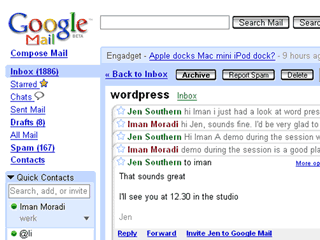
Feed reader, conversation view and instant messaging list.
With Gmail, you can simply search for emails instead of sorting them, and unlike other large web based email providers of a couple of years ago, the whole page doesn’t refresh needlessly page by page in order to display your email. In fact in terms of functionality and user experience, when Gmail arrived, it was closer to a desktop based application than anything else on offer at the time. Other large web based email providers such as Yahoo mail and Microsoft Hotmail have since followed suit.
Currently, Gmail’s main interface combines a feed reader (for showing you news items from your favourite sites) an instant messaging application (allowing you to converse with contacts in real-time), and it also has a very useful email clustering tool which groups related emails and their replies together. Although these features are available in separate products and have existed for some time in other places, Gmail found a way of packaging them all together (by generating enough revenue from targeted advertising) and provided the service for free on the web.[9]
Google’s Gmail now integrates with a suite of other tools such as Google Calendar and Google Docs and Spreadsheets, each other product allows you to share your data with other users with relative ease. For example you can share a calendar with other users, share documents and edit them collaboratively in one place to eliminate the need for excessive emailing and the chore of revision tracking. [10]
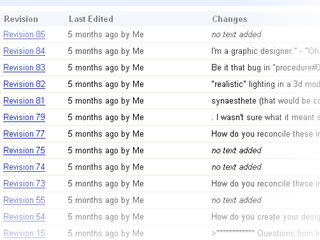
Google docs revision tracking
Recently, myself and other collaborators decided to use a shared Gmail account extensively over the course of three years to track submissions for art and design book collaboration. Without it, it would have been very difficult to keep track of the 700 or so submissions we received from over 200 people. Additionally, we used Google Spreadsheets to comment on these submissions and work together on editing essays and interviews. Using social software greatly simplified the task at hand, in that we mainly worked on it during weekends away from regular work.
With all the functionality and interactivity which Gmail offers, there are some other issues associated with the use of Gmail which have made privacy advocates quite worried. They primarily relate to Google’s policies regarding the use, analysis and retention of user data.
It's noteworthy to mention that although as editors of the book, we consented to have our sent and received emails scanned by Google’s software to show targeted advertising (as the cost of having a free service) the people sending us email did not explicitly enter into any agreement to do so, to essentially have the contents of their emails to us scanned [11]. Neither did they agree to Google's vague data retention policies, which can keep emails (even deleted ones) on the system indefinitely.[12]
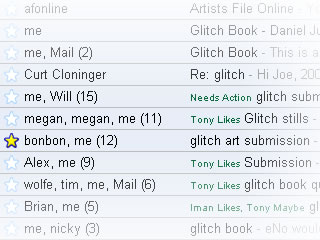
Cropped portion of Gmail inbox interface, with correspondence clustering and labelling for messages.
Tagging / Folksonomies
Another great example to illustrate some of these key differences and familiarise you with common facets of many Web 2.0 applications is del.icio.us [13]. Delicious, which is now owned by Yahoo, is a social bookmarking tool. It’s a website and service which can integrate with your internet browser using a number of easy to install plug-in’s. It basically allows you to bookmark web pages which you find interesting with two clicks. You are then able to access these links from any web browser, see what others are linking to and perhaps share your own links with specific users by forming networks.
On surface there is nothing new to the storage of bookmarks aspect. For years, web browsers have had Favourites or Bookmarking functionality in-built, so the web pages which you frequently visit or find interesting can be retrieved later so long as you bookmark them or add them as a Favourite.
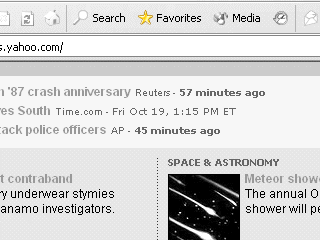
Bookmark feature in Internet Explorer 6.
But anyone who has used Favourites knows too well the problem of having many links to different sites, with non-descriptive names and the pain of not being able to find a particular site again. Also, you may end up changing computers without backing up your links or you wish to retrieve your links at someone else’s computer or at work and suddenly the non portable Favourites situation inside your browser seems quite limiting.
With Delicious, which is one of the largest social bookmarking sites, instead of storing your links on your computer, you save them onto a designated area on the Delicious website, and these links are associated with your username.

Screenshot of a users delicious bookmarks feed.
As well as allowing other people to view your links and allowing you to view their links, Delicious offers an interesting way to search for and organise these links. You assign your own ‘tags’ or descriptive keywords to each link you save and in effect this assists in retrieving them later.
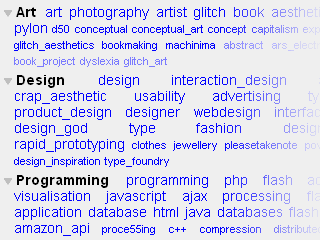
Crop of a clustered tag cloud. Showing frequency of tags visually.
Being able to tag items using a specialist vocabulary and the practice of doing so collaboratively, referred to as a Folksonomy [14], clearly has its benefits over taxonomies and rigid information hierarchies [15], and it has some drawbacks too.
Firstly, consider how a Dewey organised physical library can be so inherently confusing without knowing what the numeric shelf designations represent or without the benefit of having a library catalogue search tool or librarian at hand. Anyone can effectively become a subject specialist or categoriser within folksonomies, and therein lies a potential benefit and incentive, especially to categorise niche and newly emerging phenomenon.
Secondly, we could consider that freely allowing categorisation could also create Metanoise [16] which relates to inaccurate, erroneous, incomplete, or irrelevant data which is associated with any described item. [17]
Either way due to the large numbers using such services, any form of democratisation of the categorisation and description process can potentially be beneficial especially to minority users. (Scott Bateman 2006) [18]
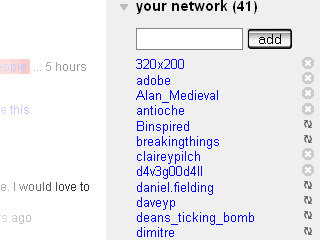
A user's personal network of other delicious users.
According to Thomas Van Der Wall (2005), who coined the phrase Folksonomy, “Who is doing the tagging is important to understand”. Using Delicious, as well as simply retrieving previously bookmarked content, we can actively share it with others too. Delicious also allows you to form your own network and permits you to send any link to specific people in your network.
Some of the key features of Delicious are replicated across other systems. Collaborative content or knowledge filtering happens because we can see what others have shared and how they’ve described it. Searches for items unknown by name can instantly become quite fruitful if we know or can guess what others may categorise them as.
Additionally, when you bookmark an item you can discover who else has bookmarked it too; a quick visit to their bookmarks may uncover other hidden gems.
“Folksonomy tagging can provide connections across cultures and disciplines (a knowledge management consultant can find valuable information from an information architect because one object is tagged by both communities using their own differing terms of practice)” (Thomas Van Der Wall, 2005) [19]
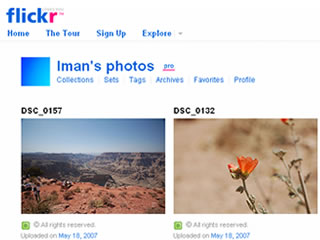
Screenshot showing a crop of a personal Flickr page.
Flickr, which is a photo sharing website, allows the same affordances for personal photos and builds on the social network aspect quite extensively, while enriching photos with user provided tags.
According to Stewart Butterfield, one of Flickr's co-founders. "The job of tags isn't to organize all the world's information into tidy categories, It's to add value to the giant piles of data that are already out there." [20] Photo sharing websites have existed on the web but none have succeeded in adding as much value and use to our personal photos.
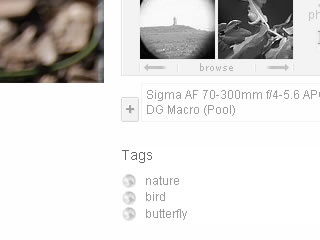
A crop of the photo detail page on Flickr showing three tags and a group (pool) which the photo belongs to.
While both these tools are successful and used by many, it's important to also state that there is a wealth of information which has yet to be fully utilised by the company which now owns both products, Yahoo!
In 2006, Yahoo’s former Chief Operating officer was quoted referring to the monetization of Flickr in due course. [21] “We have products like Flickr that are not yet really monetized right now.” and exactly how is something which will no doubt be informed and facilitated in part by “…user data about who they are and what they have done,…” although this wasn’t a wildly outrageous statement, it can be seen to go against the grain of the founding spirit of some of these tools, which weren’t initially designed, based and led by plans for monetary profit.
Social Networks
If you have a blog you are said to contribute to the blogosphere [22] which is the idea that blogs exist within a community. If you upload your photos to Flickr and add your friends to your contacts list you have formed a social network. The term friend can sometimes denote a looser designation in internet mediated communication and especially web 2.0 applications, than it does offline, and the term social network signifies the numerous types of connection between users of a website.
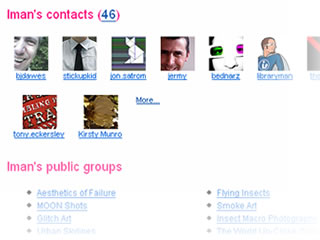
view of contacts page on Flickr.
The phenomenon of social networking sites [23] however, actually refers to websites which literally focus on showing, verifying and facilitating links between people sharing similar interests or members of particular groups. Wikipedia maintains a growing list of these sites [24]. I’ve taken Facebook, currently the seventh most popularly visited site on the web as an example. [25]
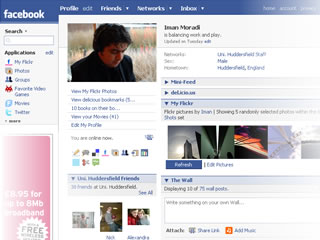
A typical facebook profile page.
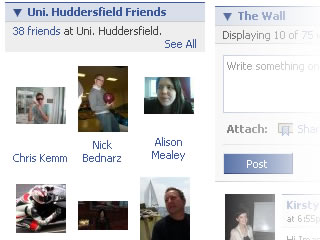
Facebook Friends list.
Facebook is a closed community which means you have to register or be invited before accessing many of the functions on the site, it allows you to keep a list of friends across various networks which you belong to. It incorporates messaging functionality, photo hosting, and status notifications as well as groups within its highly interactive profile pages.
It also allows developers to create applications which extend the core functionality of Facebook and utilise the power of existing networks to spread.

Facebook Visual Bookshelf Third Party Application.
Facebook also demonstrates the power for information to be replicated and viewed within different frames on different sites. When I bookmark something on delicious I’ve opted to have my recent bookmarks displayed within my Facebook profile as well.

Facebook Feed, displaying Delicious bookmarks as they happen.
Likewise, I can have my Flickr photos displayed on there too. Some of this has been made possible using RSS or really simple syndication and other agreed protocols and methods for sites to inter-operate. In the case of RSS feeds, essentially my Flickr photos, my Delicious bookmarks or my Wordpress blog posts have their own automatically generated file which other sites, or feed readers can utilise to link to my freshly updated content. Facebook literally grabs the most recent information you allow it to (links and photos) and redisplays it within your profile page.
Although all of this aggregation is currently by choice, there are many aspects to the Facebook experience which have come under fire from critics as being far from the in users control or deliberately confusing. [26] Facebook doesn’t offer the same amount of granular control which Flickr offers for individual items of data on your profile being accessible or locked away. Joining a large network, by default, allows members of that network to view your page without restriction.
Privacy advocates and ordinary users who have lost their basic privacy due to the illusion of privacy which Facebook fosters are naturally outraged. There have been concerns over colleges in the US taking action against their students based on specific Facebook activity [27], and a notable case with MySpace [28] where a 27-year-old student teacher was allegedly denied teaching credentials as her photo labeled drunken pirate, depicting her holding a plastic cup (possibly containing alcohol), was deemed "unprofessional" and encouraged underage drinking.
A critical view of recent developments
We are experiencing a time of rapid change and development, where many possibilities exist in the use of the current offering of technologies and tools, to great benefit. Up to this point in this article, a number of these tools have been profiled while mentioning some of the potential implications and concerns over misuse of the data we are willingly sharing. There is very little debate that these tools are simplifying previously complex tasks and enabling us to do things quicker, with less hassle, but what else are they enabling? Are we discovering these features and the full extent of their reach only when it’s too late?
“information collected by many Web sites — browsing histories, search histories, wish lists, preferences, purchase histories — is amassed and manipulated in ways consumers never know about.” [29]
On Social networking sites, we can profile our musical interest, our reading lists, political affiliations and educational history, we can form groups with other people, and have discussions within those groups. Essentially new forms of expressing our interests and telling people what we are doing every minute of every day are being developed and popularly accepted. But given the clandestine nature of what goes on behind the scenes and those broadly worded terms of service agreements, it does seem strange that we are voluntarily submitting quite so much personal information, for other individuals and establishments to peruse with such ease.
With something as simple as advertising that is being displayed on Gmail pages, there was initially a reasonable amount of controversy which surrounded Google’s fabled content extraction technology. Essentially this feature delivers highly targeted, relevant advertising in relation to the contents of your email. Information concerning the geographic origins and local time of your email correspondent is allegedly amongst the things which content extraction uses and analyses. One could argue that these businesses are legitimately driven by profit, and therefore need to utilise ingenious methods to conduct business, but how far are we letting them go? Is our data and reputation more valuable to us than the price they place on it?
Literally speaking, “MySpace was sold in 2005 for a price that corresponded approximately to 35 US$ per user profile. In 2006 Facebook sources suggested a valuation for their network of 2 billion US$ which would translate to 286 US$ per user profile” (Giles Hogben, 2007), yet the damage that could be done by an invasion of privacy comes at much higher costs.
“The consequences of misusing Facebook can damage a student's chances for their career and hinder their social life.” (Brandon J. Mendelson 2005) [30]
Privacy International which are a human rights group, in a recent survey of several web based services and companies, deemed Google to be hostile to user privacy. They also identified breaches in several other services and their offerings. [31] Primarily, it's the lack of transparency and clarity regarding some of the issues raised in this article which are worrying, as they can set irreversible trends and lower the expectations of the levels of privacy by future users if we become complacent and accepting of the current methodologies for handling our privacy matters.
While the companies themselves aren’t necessarily out to get us, their attitudes and responsibilities towards protecting our data are questionable. Facebook's relationship with third party developers is an example of such. Third parties who develop applications for Facebook aren’t vetted by Facebook and their seemingly innocuous applications can access our user data. Or as some users have found, we are not in full control of our membership, [32] to the point that it’s very difficult to leave such sites without considerable effort.
As other users of these communities have found out, the slightest criticism of the service itself is sometimes met with very heavy handed resistance and censorship [33]. There have also been well documented cases of data retention and privacy concerns of companies such as Yahoo which have affected the lives of political activists in countries such as China [34].
With all the affordances web mediated communication and specifically web 2.0 services offer us, and all of their benefits, it's good to bear in mind that there is after all no such thing as a free lunch, and to constantly assume that privacy is very fragile and never guaranteed in the hands of fickle multinational corporations.
Other Services not mentioned in this article
Wordpress.com allows anyone to create and maintain their own weblogs. http://wordpress.com/
Writeboard is a collaborative word processor which makes keeping note of revisions and collaborating with others on writing a document simple to manage. http://writeboard.com
Tadalist facilitates the creation of easy to use to-do lists. http://tadalist.com
Upcoming is a service which allows you to create, manage & share listings for events. http://upcoming.org
Meebo is an in-browser instant messaging program, which supports multiple IM services, including Yahoo! Messenger, Windows Live Messenger, Google Talk, AIM, ICQ, and Jabber. Meebo also makes it easy to create instant rooms for mini conferences just by sharing a web address. http://meebo.com
Last.fm is an online radio and music based profiles site which allows you to profile your musical taste, and discover new music. http://last.fm
Librarything – allows you to catalogue & share your personal library. http://librarything.com
ELGG - As used by http://community.brighton.ac.uk is an open source social platform and content management system. http://elgg.org/
Bibsonomy, CiteULike, Connotea are further examples of social bookmarking tools.
http://www.bibsonomy.org , http://www.citeulike.org , http://www.connotea.org
Notable Project / Organisation
Attention Trust is an organisation aimed at Empowering people to exert greater control over their "attention data", leading efforts to drive developers and business leaders towards greater transparency and dialogue with users and lawmakers over privacy issues. http://attentiontrust.org/
Services mentioned in this article
Flickr allows you to upload and share your pictures online. Its one of the most successful web 2.0 services. http://flickr.com
Delicious is a fully featured social web-bookmark manager. http://del.icio.us
Google Documents, Spreadsheets and Presentations.
Document editing with publishing and collaboration features. http://docs.google.com
Google calendar system with sharing/sms notification functionality. http://calendar.google.com
References
SCOTT BATEMAN, CHRISTOPHER BROOKS, GORD MCCALLA (2006)
Collaborative Tagging Approaches for Ontological Metadata in Adaptive E-Learning Systems
GILES HOGBEN (2007), Security Issues and Recommendations for Online Social Networks
European Network and Information Security Agency, ENISA
BRANDON J MENDELSON (2005) Misuse of Facebook. Blogcritics website, [accessed October 2007]
IRINA SHKLOVSKI, S. K., ROBERT KRAUT (2004) The Internet and Social Interaction: A Meta-analysis and Critique of Studies, 1995-2003
THOMAS, VAN DER WALL (2005) Explaining and Showing Broad and Narrow Folksonomies. [accessed October 2007]
Footnotes
[1] Katz & Aspden in The Internet and Social Interaction: A Meta-analysis and Critique of Studies. http://www.cs.cmu.edu/~kraut/RKraut.site.files/articles/Shklovski04-Inte...
[2] http://en.wikipedia.org/wiki/Perpetual_beta
[3] "We may use information about you that we collect from other sources, including but not limited to newspapers and Internet sources such as blogs, instant messaging services and other users of Facebook, to supplement your profile." Facebook Privacy Policy. http://www.facebook.com/policy.php
[4] Blog post outlining and highlighting the vaguely worded / veiled threats present in Terms of Service documents which the majority of ordinary users tend to ignore. http://scholarsandrogues.wordpress.com/2007/09/02/dont-be-evil-unless-yo...
[5] http://wordpress.org Open Source Blogging Software
[6] Wordpress.com, Tumblr, Typepad, Vox, Blogger, Edublogs are all examples of hosted blogging services.
[7] http://en.wikipedia.org/wiki/Web_2.0
[8] http://en.wikipedia.org/wiki/Social_software
[9] This possibility for linking search records, browsing history, emails, photos and instant messaging conversations is seen by many as being very invasive of ones privacy. Specially in the case of linking search queries to individual users via the unified Google account. Moreover its important to note, Gmail is offering these tools for free because it can make a profit from advertising revenue, as advertising revenues fall one has to be weary of other ways in which they could potentially make money by analysing and selling our data.
[10] Googles Promotional Video for Google Docs: http://www.youtube.com/watch?v=eRqUE6IHTEA
[11] http://www.epic.org/privacy/gmail/faq.html
[12] Letter written in 2004, by thirty-One Privacy and Civil Liberties Organizations to urge Google to suspend Gmail, over concerns that they are lowering privacy expectations. http://www.privacyrights.org/ar/GmailLetter.htm
[14] http://en.wikipedia.org/wiki/Folksonomy
[15] http://www.vanderwal.net/random/entrysel.php?blog=1635
[16] http://en.wikipedia.org/wiki/Meta_noise
[17] In Metacrap, Cory Doctorow refers to seven insurmountable obstacles with regards to user categorisation or objects. http://www.well.com/~doctorow/metacrap.htm
[18] Online PDF version of “Collaborative Tagging Approaches for Ontological Metadata in Adaptive E-Learning Systems” http://www.win.tue.nl/SW-EL/2006/camera-ready/02-bateman_brooks_mccalla_...
[19] Thomas Vander Wall’s, “Explaining and Showing Broad and Narrow Folksonomies” http://www.personalinfocloud.com/2005/02/explaining_and_.html
[20] Daniel Terdiman, “Folksonomies Tap People Power.” http://www.wired.com/science/discoveries/news/2005/02/66456
[21] Yahoo! Q3 2006 Earnings Call Transcript. http://seekingalpha.com/article/18639-yahoo-q3-2006-earnings-call-transc...
[22] http://en.wikipedia.org/wiki/Blogosphere
[23] http://en.wikipedia.org/wiki/Social_network_service
[24] http://en.wikipedia.org/wiki/List_of_social_networking_websites
[25] Alexa ranking November 2007.
[26] Danah Boyd, Confused by Facebook http://www.zephoria.org/thoughts/archives/2007/09/06/confused_by_fac.htm...
[27] Misues of Facebook may cost you. http://blogcritics.org/archives/2005/12/11/213844.php
[28] http://www.bloggingstocks.com/2007/04/30/myspaces-drunken-pirate-sues-co...
http://www.thesmokinggun.com/archive/years/2007/0426072pirate1.html
[29] Online Ads vs. Privacy. NY Times http://www.nytimes.com/2007/05/12/technology/12online.html?ei=5090
[30] See 27.
[31] http://www.privacyinternational.org/article.shtml?cmd[347]=x-347-553961
[32] http://siyavash2005.googlepages.com/facebook
[33] http://www.theregister.co.uk/2007/09/14/facebook_group_deleted
[34] http://www.nytimes.com/2005/09/08/technology/08yahoo.html
Images
All images courtesy of the author.



